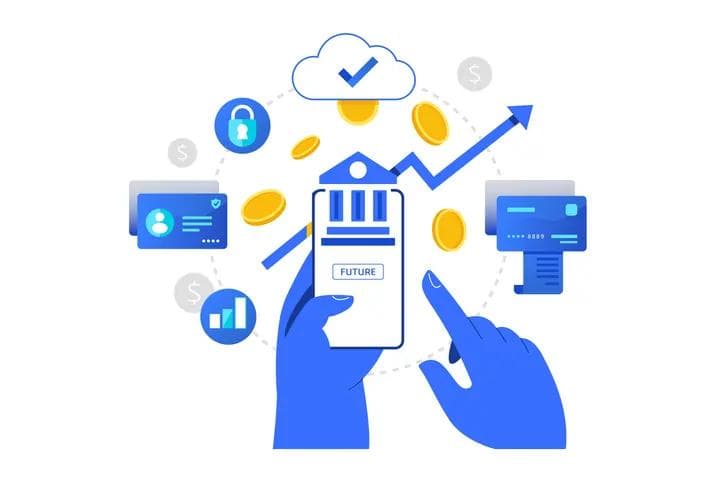Personalized Banking: Leveraging AI and Data for Tailored Financial Solutions
Personalized Banking: Leveraging AI and Data for Tailored Financial Solutions
Published by Wanda Rich
Posted on February 4, 2025

Published by Wanda Rich
Posted on February 4, 2025

Banking experience is undergoing a radical transformation. No longer confined to generic, one-size-fits-all products, financial institutions are leveraging advanced artificial intelligence (AI) and data analytics to craft highly personalized banking experiences. Today’s customers expect more than just transactional services—they demand tailored financial solutions that align with their unique goals, behaviors, and lifestyles.
A recent survey by MX found that 54% of U.S. consumers expect their financial providers to personalize their banking experience by leveraging their financial data. cross all generations—including Gen Z, Millennials, Gen X, and Baby Boomers—74% of respondents expressed a desire for more personalized services. This demand signals that personalization is no longer a luxury—it’s a necessity in modern banking.
By harnessing AI-driven recommendation systems, banks can anticipate customer needs, offer relevant financial products in real time, and enhance overall engagement. More than just convenience, this level of customization strengthens customer loyalty, drives revenue growth, and improves financial literacy. However, the shift toward hyper-personalization also raises critical questions about data privacy, regulatory compliance, and the balance between automation and human interaction—factors that will define the next era of banking.
The Role of AI and Data Analytics
Artificial Intelligence (AI) and data analytics are at the core of personalized banking. Banks are increasingly employing AI-driven algorithms to analyse customer transaction patterns, behaviours, and preferences. This enables them to anticipate customer needs and offer targeted solutions in real-time, as noted by Defi Solutions. Dynamic micro-personalization, where AI categorizes client segments based on real-time data, allows banks to design products on the fly and combine solutions that meet individual client needs, as discussed by WaveCX. This approach not only enhances customer satisfaction but also optimizes operational efficiency by reducing the time and resources spent on developing one-size-fits-all solutions.
Benefits of Personalized Banking
The advantages of personalized banking go beyond improving customer satisfaction—they drive revenue growth, strengthen customer loyalty, and enhance financial literacy.
By addressing individual financial needs, personalization fosters a sense of value and trust, leading to deeper customer relationships. This tailored approach significantly impacts customer retention, with 78% of consumers stating they would continue using their bank if they received personalized support. However, despite this demand, only 44%of banks currently provide such services, according to Astera.
This gap presents a major opportunity for financial institutions to differentiate themselves by investing in data-driven, customer-centric strategies that align with evolving consumer expectations. Banks that embrace personalization can build stronger connections, enhance loyalty, and ultimately secure a competitive edge in the market.
Revenue Growth Through Personalization
By leveraging data analytics, banks can uncover new opportunities to offer products and services that align with customer needs, driving both cross-selling and upselling. This strategic approach benefits both customers and financial institutions by broadening product offerings and increasing revenue streams, as noted by Astera. With a deeper understanding of customer behavior and preferences, banks can present tailored financial solutions at the most relevant moments, boosting adoption rates and enhancing the overall banking experience.
Financial Literacy and Education
Personalized banking also includes providing dedicated educational materials to enhance customers' understanding of complex financial concepts. This approach not only improves financial well-being but also fosters long-term relationships between banks and their customers. According to a report by BISA Portfolio, financial institutions that prioritize financial literacy initiatives empower customers to make informed decisions, ultimately building trust and loyalty that extends beyond transactional interactions.
Technological Integration and Innovation
The integration of advanced technologies is reshaping the landscape of personalized banking, making it more seamless, efficient, and customer centric. As artificial intelligence (AI), big data analytics, and machine learning continue to evolve, banks are embracing digital transformation to deliver hyper-personalized financial experiences, enhance engagement, and streamline operations.
Seamless Integration Across Channels
Omnichannel banking trends emphasize seamless integration across mobile, web, ATMs, and in-branch services, enhancing convenience and accessibility, as discussed by Defi Solutions. Today’s consumers expect to transition between platforms effortlessly starting a transaction on their mobile app, receiving real-time notifications on their smartwatch, and completing it in a branch without disruptions. AI-driven chatbots and voice assistants enable conversational banking, allowing users to check balances, transfer funds, and receive personalized financial insights through natural language processing (NLP). This seamless connectivity creates a consistent and cohesive banking experience across all customer touchpoints.
Predictive Analytics and Proactive Solutions
Banks are leveraging predictive analytics to anticipate customer needs and offer proactive solutions. AI-powered systems analyze spending habits, transaction histories, and behavioral patterns to recommend financial products, suggest budgeting strategies, and detect potential financial risks. For example, a bank could notify a customer about an upcoming bill, suggest customized loan options, or recommend an investment product based on past behaviors, as highlighted by First Bank.
Predictive analytics also plays a crucial role in cross-selling and customer retention by offering relevant financial products at the right time. By understanding customer preferences and anticipating future needs, banks can increase customer engagement while optimizing operational efficiency.
AI-Powered Personalization and Real-Time Financial Insights
Beyond predictive analytics, AI-driven recommendation engines are transforming personalized banking. Instead of generic financial advice, customers receive tailored recommendations based on real-time financial behavior. Whether it’s optimizing credit card usage, suggesting investment opportunities, or providing customized loan repayment plans, AI ensures that financial advice is highly relevant and actionable.
One key development is dynamic micro-personalization, where AI categorizes customers into unique segments in real-time. As discussed by WaveCX, this enables banks to design financial products on the fly, combining multiple solutions to meet individual client needs.
Voice Banking and Conversational AI
AI-driven voice assistants are redefining how customers interact with their banks. Through natural language processing (NLP), voice banking enables users to conduct transactions, set financial goals, and receive budget insights using simple voice commands. This hands-free approach enhances accessibility, particularly for individuals with disabilities or those who prefer voice interactions over traditional interfaces.
Blockchain and Decentralized Finance (DeFi) Integration
As blockchain technology gains momentum, financial institutions are exploring its potential in secure, transparent, and efficient banking solutions. Smart contracts allow for automated loan processing, reducing paperwork and speeding up approvals, while blockchain-powered cross-border payments settle in seconds rather than days.
Decentralized finance (DeFi) is another disruptive trend, providing customers with alternative financial services, such as peer-to-peer lending and digital asset management, without relying on traditional intermediaries. As banks explore digital asset custody and tokenized financial products, blockchain’s role in personalized banking is expected to expand.
Augmented Reality (AR) and Virtual Reality (VR) in Banking
Emerging technologies like AR and VR are reshaping customer engagement in banking. Virtual bank branches enable customers to interact with financial advisors in immersive digital environments, while AR applications provide interactive financial data visualization—allowing users to see real-time stock market trends or mortgage options with a tap of their screen. These technologies are opening new ways for banks to engage customers, making financial decision-making more interactive and intuitive.
Cybersecurity and Data Protection in a Personalized Era
As banking becomes more personalized, the vast amount of customer data being processed raises concerns about privacy and security. Financial institutions are implementing advanced encryption, biometric authentication (facial recognition, fingerprint scanning), and AI-driven fraud detection systems to protect sensitive information.
Data transparency is also becoming a priority. Banks must balance leveraging customer data for personalization with ensuring compliance with regulations like GDPR and CCPA, fostering trust and confidence among customers.
The Future of Technology in Personalized Banking
As innovation continues to drive banking transformation, the next phase will focus on:
Personalized banking will no longer be just an added feature—it will be the foundation of a truly customer-centric banking model, driven by technology, trust, and tailored financial experiences.
Digital-First Strategy
Digital banking is becoming a staple across generations, with 55% of consumers choosing to conduct their banking online and 48% accessing their mobile apps daily. Digital channels prioritize eco-friendly operations and transparency, appealing to environmentally conscious customers, as noted by Defi Solutions. As digital banking becomes the norm, banks must continue to innovate and adapt to meet the evolving needs of their customers, ensuring that their digital offerings remain relevant and engaging.
Innovative Engagement
Banks are expanding AR/VR for virtual bank branches and immersive financial experiences, enhancing customer engagement, as highlighted by Defi Solutions. Decentralized finance (DeFi) and blockchain integration will continue to gain traction, offering smart contracts, cross-border payments, and asset management, as discussed by First Bank. These innovations not only enhance the customer experience but also open new opportunities for banks to differentiate themselves in a competitive market.
Challenges and Considerations
While the benefits of personalized banking are clear, there are challenges that banks must navigate to fully realize its potential.
Data Privacy and Security
As banks collect and analyse vast amounts of customer data, ensuring data privacy and security becomes paramount. Consumers are increasingly concerned about how their data is used and protected. Financial institutions must implement robust security measures and transparent data policies to build trust and confidence among their customers. By prioritizing data privacy and security, banks can mitigate risks and foster a sense of trust and loyalty among their customers.
Balancing Personalization and Automation
While automation and AI are essential for delivering personalized experiences, banks must strike a balance between technology and human interaction. Customers still value personal connections and the ability to speak with knowledgeable representatives when needed. Banks should focus on integrating technology in a way that enhances, rather than replaces, human interactions. By maintaining a human touch, banks can ensure that their personalized services remain authentic and meaningful.
Regulatory Compliance
The financial industry is heavily regulated, and banks must navigate complex compliance requirements when implementing personalized services. Ensuring compliance with regulations such as GDPR and CCPA is critical to avoid legal pitfalls and maintain customer trust. By staying informed and proactive about regulatory changes, banks can ensure that their personalized services remain compliant and trustworthy.
Personalized banking services represent the future of the financial industry, offering significant benefits for both consumers and banks. By leveraging customer data and advanced recommendation systems, banks can deliver tailored experiences that enhance customer satisfaction, drive revenue growth, and improve financial literacy. However, to fully realize these benefits, banks must address challenges related to data privacy, automation, and regulatory compliance. As technology continues to evolve, personalized banking will play an increasingly important role in shaping the future of finance.
Explore more articles in the Banking category











